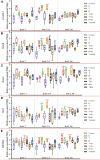Osteochondrogenesis by TGF-β3, BMP-2 and noggin growth factor combinations in an ex vivo muscle tissue model: Temporal function changes affecting tissue morphogenesis
- PMID: 37008034
- PMCID: PMC10060664
- DOI: 10.3389/fbioe.2023.1140118
Osteochondrogenesis by TGF-β3, BMP-2 and noggin growth factor combinations in an ex vivo muscle tissue model: Temporal function changes affecting tissue morphogenesis
Abstract
In the absence of clear molecular insight, the biological mechanism behind the use of growth factors applied in osteochondral regeneration is still unresolved. The present study aimed to resolve whether multiple growth factors applied to muscle tissue in vitro, such as TGF-β3, BMP-2 and Noggin, can lead to appropriate tissue morphogenesis with a specific osteochondrogenic nature, thereby revealing the underlying molecular interaction mechanisms during the differentiation process. Interestingly, although the results showed the typical modulatory effect of BMP-2 and TGF-β3 on the osteochondral process, and Noggin seemingly downregulated specific signals such as BMP-2 activity, we also discovered a synergistic effect between TGF-β3 and Noggin that positively influenced tissue morphogenesis. Noggin was observed to upregulate BMP-2 and OCN at specific time windows of culture in the presence of TGF-β3, suggesting a temporal time switch causing functional changes in the signaling protein. This implies that signals change their functions throughout the process of new tissue formation, which may depend on the presence or absence of specific singular or multiple signaling cues. If this is the case, the signaling cascade is far more intricate and complex than originally believed, warranting intensive future investigations so that regenerative therapies of a critical clinical nature can function properly.
Keywords: BMP-2; TGF-β3; muscle tissue; noggin; temporal modulation; tissue engineering.
Copyright © 2023 Liu, Müller, Aszódi and Klar.
Conflict of interest statement
The authors declare that the research was conducted in the absence of any commercial or financial relationships that could be construed as a potential conflict of interest.
Figures









Similar articles
-
Temporal TGF-β Supergene Family Signalling Cues Modulating Tissue Morphogenesis: Chondrogenesis within a Muscle Tissue Model?Int J Mol Sci. 2020 Jul 9;21(14):4863. doi: 10.3390/ijms21144863. Int J Mol Sci. 2020. PMID: 32660137 Free PMC article.
-
New scaffolds encapsulating TGF-β3/BMP-7 combinations driving strong chondrogenic differentiation.Eur J Pharm Biopharm. 2017 May;114:69-78. doi: 10.1016/j.ejpb.2016.12.021. Epub 2017 Jan 10. Eur J Pharm Biopharm. 2017. PMID: 28087378
-
The induction of bone formation by the recombinant human transforming growth factor-β3.Biomaterials. 2014 Mar;35(9):2773-88. doi: 10.1016/j.biomaterials.2013.12.062. Epub 2014 Jan 15. Biomaterials. 2014. PMID: 24438909
-
Developmental pathways of periodontal tissue regeneration: Developmental diversities of tooth morphogenesis do also map capacity of periodontal tissue regeneration?J Periodontal Res. 2019 Feb;54(1):10-26. doi: 10.1111/jre.12596. Epub 2018 Sep 12. J Periodontal Res. 2019. PMID: 30207395 Review.
-
Redundancy and Molecular Evolution: The Rapid Induction of Bone Formation by the Mammalian Transforming Growth Factor-β3 Isoform.Front Physiol. 2016 Sep 8;7:396. doi: 10.3389/fphys.2016.00396. eCollection 2016. Front Physiol. 2016. PMID: 27660615 Free PMC article. Review.
Cited by
-
Engineering growth factor gradients to drive spatiotemporal tissue patterning in organ-on-a-chip systems.J Tissue Eng. 2025 Apr 18;16:20417314251326256. doi: 10.1177/20417314251326256. eCollection 2025 Jan-Dec. J Tissue Eng. 2025. PMID: 40290860 Free PMC article.
-
3D bioprinted scaffolds for osteochondral regeneration: advancements and applications.Mater Today Bio. 2025 May 8;32:101834. doi: 10.1016/j.mtbio.2025.101834. eCollection 2025 Jun. Mater Today Bio. 2025. PMID: 40487176 Free PMC article. Review.
-
The 3D-McMap Guidelines: Three-Dimensional Multicomposite Microsphere Adaptive Printing.Biomimetics (Basel). 2024 Feb 6;9(2):94. doi: 10.3390/biomimetics9020094. Biomimetics (Basel). 2024. PMID: 38392141 Free PMC article.
-
SOX9 haploinsufficiency reveals SOX9-Noggin interaction in BMP-SMAD signaling pathway in chondrogenesis.Cell Mol Life Sci. 2025 Mar 2;82(1):99. doi: 10.1007/s00018-025-05622-y. Cell Mol Life Sci. 2025. PMID: 40025280 Free PMC article.
-
Single-Cell Approaches Define the Murine Leptomeninges: Cortical Brain Interface as a Distinct Cellular Neighborhood Composed of Neural and Non-neural Cell Types.eNeuro. 2025 Aug 22;12(8):ENEURO.0046-25.2025. doi: 10.1523/ENEURO.0046-25.2025. Print 2025 Aug. eNeuro. 2025. PMID: 40780964 Free PMC article.
References
-
- Alliston T., Piek E., Derynck R., Miyazono K., Derynck R. (2008), TGF-Beta family signaling in skeletal development, maintenance, and disease. 667
LinkOut - more resources
Full Text Sources

